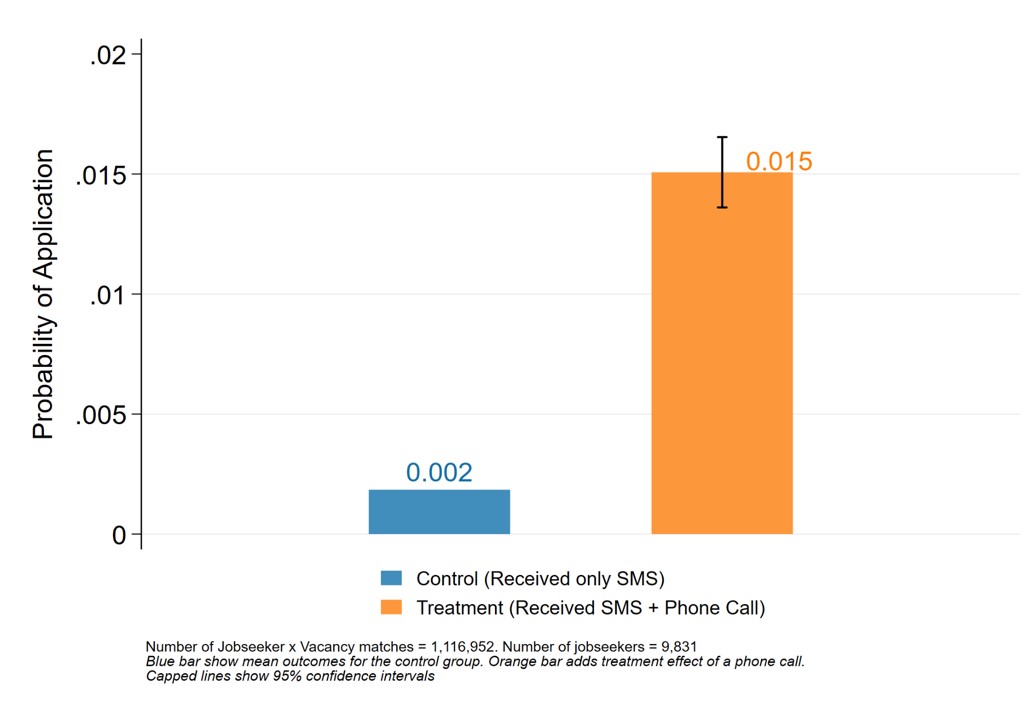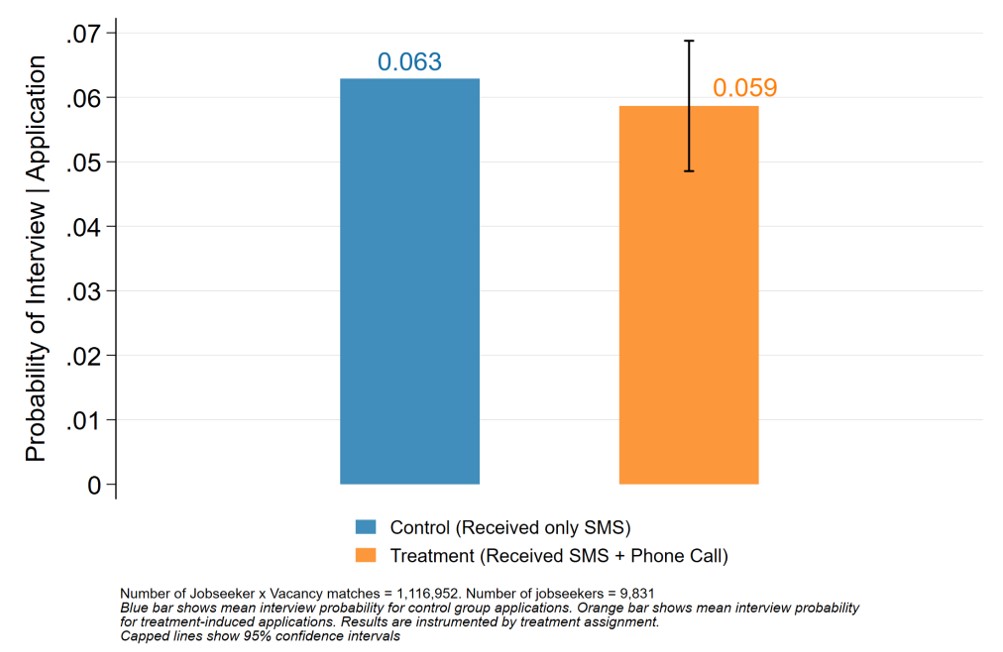
Lowering the psychological cost of initiating job applications dramatically increases application rates without lowering the average return to each job application
Job search is a central feature of labour markets and barriers to job search can have important economic consequences. For instance, in macroeconomic models, barriers or “frictions” to search can help to explain both employment levels and the productivity of matches between firms and workers (Shimer 2010). Job search frictions can also explain variation across countries in workers’ earnings and job security (Donovan et al. 2023).
Economists have studied many specific job search frictions ranging from financial search costs to incomplete information (e.g. Abebe et al. 2021a, 2021b, Abel et al. 2020, Bandiera et al. 2021, Belot et al. 2018, Carranza et al. 2022, Franklin 2017). This suggests that environments offering cheaper and faster applications with easier access to information might improve search outcomes. But job application rates can be low even on large online job search and matching platforms that provide this environment (Jones & Sen 2022, Wheeler et al. 2022)
In new research (Field et al. 2023), we explore how psychological costs of initiating job applications might act as a barrier to high-return search. This complements a small but growing literature on behavioural barriers to job search, which has studied the role of action plans, present bias, and reference dependence (Abel et al. 2020, DellaVigna et al. 2017, Paserman 2008).
Overview of the research
We study this phenomenon using data from a novel job search platform called “Job Talash'' in Pakistan. We recruited platform users through a representative survey of over 50,000 households in Lahore, Pakistan. At the time of sign-up, these jobseekers varied widely in their employment and job search status, ranging from employed and searching to non-employed and non-searching. This sample breadth is unusual in experimental job search studies (Poverty Action Lab 2022). Using the platform requires only basic literacy, a simple phone, and almost no airtime, generating very few technological and financial barriers to search.
Through the platform, we prompt employers every month to list any new vacancies. We match jobseekers on the platform to these new vacancies based on their education, work experience, and occupational preferences. When users match to a new job, we send them a text message inviting them to apply and then forward their applications to employers. This system generates rich data on both supply and demand sides of the labour market: job attributes, application and interview decisions, and how jobseekers update their CVs over time. This yields a very precise description of the job search process up to the interview stage.
We randomly assign some jobseekers to get a phone call after their text message. The phone call informs them about the jobs they’ve matched to and invites them to initiate an application, without providing any additional information or encouragement. Meanwhile, control group users must call the platform or ask the platform to call them to initiate job applications. Thus, the treatment only changes how jobseekers initiate applications on the platform, moving them from an active role to a passive role.
More applications and more interviews
We find that the phone call treatment increases the job application rate by a dramatic 600%. Figure 1 panel A shows that the probability that treated respondents apply to a job is 1.5%, far higher than the control group’s 0.02%.
Additionally, the benefit (return) from these additional applications, measured as interview invitations, is roughly constant rather than decreasing. Figure 1 panel B shows that the average treatment-induced application has a 5.9% probability of an interview invitation. This is very similar to the 6.3% mean interview probability for control group applications.
Roughly constant returns to job search raises a question: why do jobseekers not apply to more jobs in the absence of treatment, especially given the low cost of applying on the platform? We argue that psychological costs of initiating applications are the most likely explanation for our main results. Existing research suggests multiple types of psychological costs that might be reduced by phone call treatment. It might reduce attention costs as jobseekers don’t need to pay attention to text messages and set time aside to go over the content and decide whether to apply. Control group job seekers might not initiate applications due to fear of rejection, while the treatment allows jobseekers to apply ‘in the moment’. The phone call might prevent job seekers from procrastinating and instead acts as a source of encouragement to apply earlier and miss fewer deadlines.
We can rule out many other possible explanations for these results. Monetary and time costs are unlikely to explain why untreated jobseekers don’t send more applications. Job applications on Job Talash are already cheap and fast, and other treatments designed to reduce monetary and time costs don’t increase applications much. The phone call initiation treatment also has limited effects on other ways of using the platform (e.g. improving CV quality) and on jobseekers’ beliefs about the value of applying on the platform.
More applications don’t hurt other jobseekers
Increased job search may have spillover effects on firms and other jobseekers. For firms, the direction of this effect is ambiguous: the probability of receiving a well-matched applicant is higher so firms might interview more applicants. But it can increase congestion costs if firms need to review poorly-matched applicants. For jobseekers, competing with additional applications from treated jobseekers might lead to fewer job interviews. We find that additional search has no negative spillovers. We suggest three possible explanations for this. Firstly, spillover effects might be zero if firms hire more when they receive more applications above their reservation hiring quality. Secondly, firms in this context report filling only 60% of vacancies, so more offers need not mechanically lead to crowd-out. This matches patterns on some other job search platforms (Fernando et al. 2023, Horton & Vasserman 2021). Thirdly, application volumes on this platform are relatively low; firms report in surveys that they receive on average 30% of their total applications through the platform. Taking these factors together, it is possible that firms in this labour market receive too few suitable applications in the absence of treatment for crowd-out to be relevant, at least at the interview stage.
Figure 1: Effect of phone call initiation treatment on job applications and interviews
Panel A: Treatment effect on applications

Panel B: Constant returns to application across treatment & control

Implications
This study shows that simple changes to job search processes can increase search and improve search outcomes, most likely by reducing the psychological cost of initiating applications. This highlights the importance of considering the psychology of job search, especially when combined with existing work showing that simple plans and reminders can increase job search (Abel et al. 2019, Caria et al. 2023).
Our work has important implications for the design of job search policies and platforms. Most obviously, job search platforms can simplify the process of starting job applications or evaluating job listings on job search platforms, which can potentially yield a higher number of applications and interviews. More generally, our results suggest other policies designed to increase job search should consider ways to reduce the psychological costs of initiating applications. For example, governments using job search subsidies or requirements could link payments more tightly to specific applications.
References
Abebe, G, S Caria, M Fafchamps, P Falco, S Franklin, and S Quinn (2021a), “Anonymity or Distance? Job Search and Labour Market Exclusion in a Growing African City,” Review of Economic Studies, 88(3).
Abebe, G, S Caria, M Fafchamps, P Falco, S Franklin, S Quinn, and F Shilpi (2021b), “Matching Frictions and Distorted Beliefs: Evidence from a Job Fair Experiment,” Working paper, University of Oxford.
Abel, M, R Burger, E Carranza, and P Piraino (2019), “Bridging the Intention-Behavior Gap? The Effect of Plan-Making Prompts on Job Search and Employment,” American Economic Journal: Applied Economics, 11(2): 284–301. VoxDev column.
Abel, M, R Burger, and P Piraino (2020), “The Value of Reference Letters: Experimental Evidence from South Africa,” American Economic Journal: Applied Economics, 12(3): 40–71. VoxDev column.
Bandiera, O, V Bassi, R Burgess, I Rasul, M Sulaiman, and A Vitali (2021), “The Search for Good Jobs: Evidence from a Six-year Field Experiment in Uganda,” Working paper. VoxDev Column.
Belot, M, P Kircher, and P Muller (2018), “Providing Advice to Jobseekers at Low Cost: An Experimental Study on Online Advice,” Review of Economic Studies, 86(4): 1411–1447.
Caria, S, G Gordon, M Kasy, S Quinn, S Shami, and A Teytelboym (2023), “An Adaptive Targeted Field Experiment: Job Search Assistance for Refugees in Jordan,” Journal of the European Economic Association.
Carranza, E, R Garlick, K Orkin, and N Rankin (2022), “Job Search and Hiring with Limited Information about Workseekers’ Skills,” American Economic Review.
DellaVigna, S, A Lindner, B Reizer, and J F Schmieder (2017), “Reference-Dependent Job Search: Evidence from Hungary,” Quarterly Journal of Economics, 132: 1969–2018.
Department Statistics South Africa (2021), Quarterly Labour Force Survey - Quarter 1, P0211, South Africa.
Donovan, K, W Jianyu Lu, and T Schoellman (2023), “Labor Market Dynamics and Development,” Quarterly Journal of Economics, Forthcoming.
Fernando, N, N Singh, and G Tourek (2023), “Hiring Frictions in Urban Labor Markets: Experimental Evidence from India,” American Economic Review: Insights, Forthcoming. VoxDev column.
Field, E, R Garlick, N Subramanian, and K Vyborny (2023), “Why Don’t Jobseekers Search More? Barriers and Returns to Search on a Job Matching Platform,” Working paper.
Franklin, S (2017), “Location, Search Costs and Youth Unemployment: Experimental Evidence from Transport Subsidies,” The Economic Journal, 128(614): 2353–2379.
Horton, J, and S Vasserman (2021), “Job-Seekers Send Too Many Applications: Experimental Evidence and a Partial Solution,” Manuscript, MIT.
Jones, S, and K Sen (2022), “Labour Market Effects of Digital Matching Platforms: Experimental Evidence from Sub-Saharan Africa,” Working Paper.
Matsuda, N, T Ahmed, and S Nomura (2019), “Labor Market Analysis Using Big Data: The Case of a Pakistani Online Job Portal,” Policy Research Working Paper 9063, World Bank.
Paserman, M D (2008), “Job Search and Hyperbolic Discounting: Structural Estimation and Policy Evaluation,” The Economic Journal, 118: 1418–1452.
Poverty Action Lab (2022), “Reducing Search Barriers for Job Seekers,” J-PAL Policy Insights.
Shimer, R (2010), Labor Markets and Business Cycles, Princeton University Press.
Wheeler, L, R Garlick, E Johnson, P Shaw, and M Gargano (2022), “LinkedIn(to) Job Opportunities: Experimental Evidence from Job Readiness Training,” American Economic Journal: Applied Economics, 14: 101–125.








